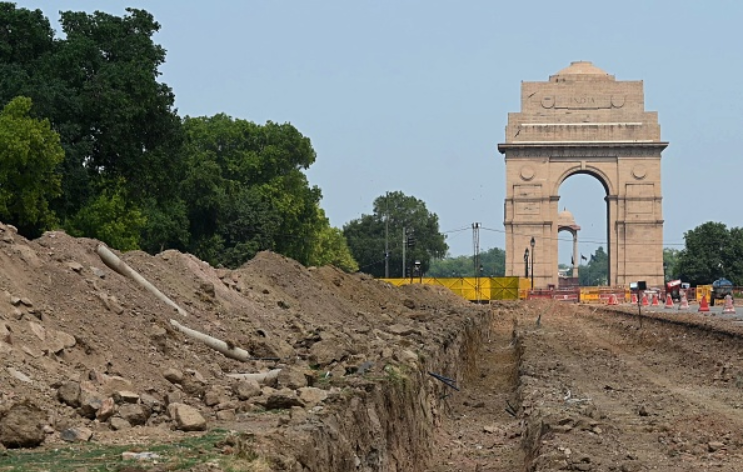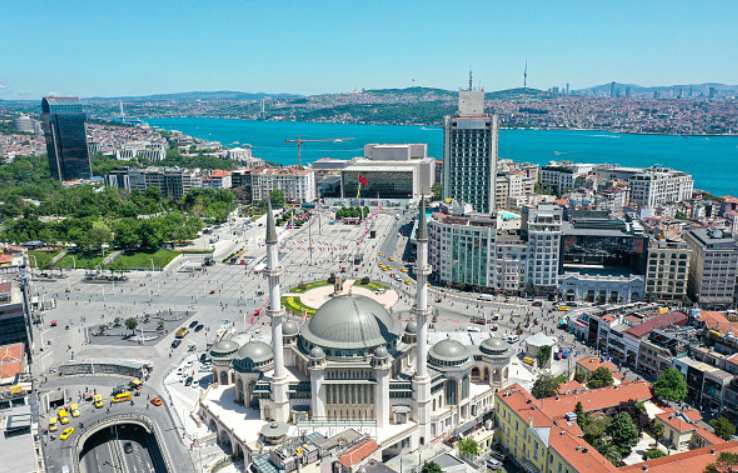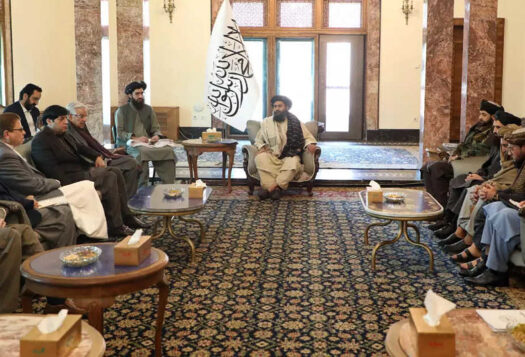
The strongman at the helm of the now partial democracy is elected to office as an outsider. He claims he will help his country mend ties with the West, liberalize, fight the corruption that has befallen the dynastic, elite party that once stewarded its national founding. He promises to amplify the voice of the mosque-and-temple goer who aspires to pray every day, though his track record includes communal violence and religious nationalism. Elected to subsequent terms, he molds truth to fit his project of national greatness, a project of personal vanity. While the country’s citizens contract viruses and lose their jobs, shrines to this new nationalism in major cities guarantee the project’s permanence: the erosion of democracy.
This is a familiar story to India and Turkey watchers. Prime Minister Narendra Modi and President Recep Tayyip Erdoğan have followed eerily similar trajectories in charge of India and Turkey and their respective right-wing populist parties. Erdoğan, who was elected in 2002 and heads the Islamist Justice and Development Party (AKP), came into power as an anti-elitist liberalizer focused on development, market-based economics, European Union accession, and grassroots advocacy in Turkey’s more conservative rural areas. Modi and his Hindu nationalist Bharatiya Janata Party (BJP) won the 2014 general elections on a platform of development, growth, and anti-corruption. Now, nearly two decades later (for Turkey) and seven years later (for India), both leaders have fashioned themselves figureheads of a new nationalism that distracts from policy failure and consolidates power in the executive.
As the world has witnessed a surge in right-wing, populist nationalism, India and Turkey provide parallel windows into schemes that merge the leader, the ethnic/religious majority, and the state. Vanity projects in urban centers—mosque construction and historical revisionism in Turkey, temple building and Central Vista renovations in India—project the power of the head of state, while the party and its supporters blame minorities and external forces for economic woes. New landmarks historicize this cult of personality, rewriting national narratives and abrading democracy as civilians barter for oxygen cylinders and mourn their dead.
Charting Historical Trajectories
Comparing India’s and Turkey’s political histories underlines the outsized importance of the individual leader in shaping national ideologies. Erdoğan and Modi are the latest iterations and have rallied historically neglected populations around new nationalisms.
India’s and Turkey’s early national histories share notable motifs: lionized national founders who became first prime ministers, at the helm of independence and later catch-all ruling parties; national ideologies centered on secularism and pluralism and carried forth by an urban, educated cultural elite; a later erosion of principles and authoritarian slide within founding parties. There are also key differences: Turkey emerged as a benevolent dictatorship with a conscious path to modernization through social engineering; India gained independence as an expansive and heterogenous democracy.
As the world has witnessed a surge in right-wing, populist nationalism, India and Turkey provide parallel windows into schemes that merge the leader, the ethnic/religious majority, and the state.
Turkey’s national father Mustafa Kemal (Ataturk) set into motion a series of top-down, radical reforms aimed at developing a modern and secular state. As part of this process, Kemal and his government disposed of all remnants of the governing caliphate, including the Sufi orders that pervaded the earlier Ottoman Empire.1 In 1945, the advent of multi-party democracy made the Republican People’s Party (CHP) the standard bearer of “Kemalism.” While scholars have argued that Kemal’s reforms were intended to be iterative—a multi-step strategy for building a modern and ultimately democratic state—the later Kemalists took his principles and transformed them into a “assertively secular” national ideology. Under this ideology and early CHP rule, the state carried out “modernization” by actively excluding religion from the public sphere and adopting authoritarian anti-dissent and anti-organization laws.2
Mohandas (Mahatma) Gandhi and Jawaharlal Nehru envisioned India as a secular, inclusive state and, through the Indian National Congress (INC), led the struggle for Indian independence from Great Britain. The INC became the Congress Party, which, with Nehru as its leader, marshalled the construction of the modern Indian nation. The new Indian state purposefully incorporated the many religious and ethnic identities present within India while leaving religion outside the public sphere.3 Congress ideology strayed increasingly from its Nehruvian origins when Indira Gandhi rigidly centralized power and shaped Congress into a cult of personality. Between 1975 and 1977, she suspended democracy by declaring a state of emergency. After Indira Gandhi’s assassination in 1984, her son Rajiv Gandhi became Prime Minister and Congress grew increasingly synonymous with corruption and dynasty politics.
The earliest iterations of the current AKP and BJP tried but failed in challenging these mainstream ideologies. Parties combined conservative, religious nationalism with populism, engaging rural voters in the political process. This includes the Turkish Democrat Party (DP), which formed a government during the 1950s, and the Jan Sangh, which emerged concurrently on the Indian political scene. In both instances, an excessive focus on political Islam and Hindu nationalism hampered the parties’ national successes.
Both countries’ current governments came to power by distancing themselves from their parties’ ideological origins. The AKP, in 2002, and BJP, in 2014, successfully campaigned on pro-market and pro-democracy platforms while engaging with their conservative, religious roots to inspire rural populations. This strategy granted the parties a wide base of support.
Elected to subsequent terms, first Erdoğan and now Modi have energized the forgotten masses around once-fringe ideologies: authoritarian political Islam and Hindu nationalism.
“Partly Free Electoral Autocracies”
India appears to be following Turkey’s lead as both political leaders have mobilized their democratically built popular support to anti-democratic ends.
While Erdoğan benefited early on from development and liberalization success, high growth rates and genuine democratization—including supporting the right to public religious expression—he now invests almost exclusively in sustaining power through top-down Islamization. Over the past fifteen years, Erdoğan and the AKP have dismantled the checks and balances previously in place to protect Turkey’s founding secularism. In 2007, after Erdogan overturned the headscarf ban and nominated a staunch Islamist for the presidency (a ceremonial role at the time), the military threatened to “make their stance abundantly clear as the absolute defenders of secularism.” When Erdoğan and his party stood against this anti-democratic “e-coup” and only garnered further support, they were emboldened to pursue overt Islamization and crack down on civil society. Barred from standing for another term as Prime Minister, Erdogan won his country’s first direct presidential election in 2014. And after trouncing an attempted coup in 2016, President Erdoğan jailed journalists, lawyers, academics and political opponents, packing Turkish courts with young, government-sympathetic judges. As of 2021, Erdoğan has molded the presidency into one-man executive rule sustained through cronyism.

Two years into his second term, Modi has set India on course to match Turkey’s authoritarianism. Elected in 2014 promising railroads and powerlines, Modi has instead overseen a period of stagnant growth, centralized power and used Hindu majoritarian politics to sell a narrative of “success” to his political base. In March 2021, the pro-democracy non-profit Freedom House demoted India from “free” to “partly free” on account of undermined institutions, suppressed political dissent and civil liberties, and a hamstrung media. The pandemic deepened this trend, as India’s most popular news outlets have refrained from broadcasting the devastation of the second wave and acknowledging the government’s missteps. Police reporting to Modi’s second-in-command, Home Minister Amit Shah, filed criminal charges, including sedition, against eight journalists who covered farmers’ protests of government agricultural reform laws. Amidst all, the Indian Supreme Court has seemed to capitulate to Modi and his majoritarian political agenda.
National and Personal Vanity
Both strongmen have married this creeping authoritarianism to right-wing nationalist ideologies, casting themselves as messiahs leading their respective nation’s return to its “authentic” cultural origins. It is this ideological project that solidifies popular support through propaganda and rewrites narratives of national founding.
Modi and Erdoğan have taken physical space and national landmarks and remodeled them to map onto their ideological imaginings. Parallel stories took form in Erdoğan’s multi-year effort to revert the Hagia Sophia—Byzantine church turned Ottoman mosque turned museum—to a mosque and Modi’s construction of a Hindu temple at Ayodhya. The temple has been a rallying cry for the Hindu right since Hindu nationalist paramilitary groups demolished the Mughal-era Babri Masjid on the grounds it was built on the birthplace of Ram. The Hagia Sophia reopened as a mosque in July 2020 and Modi lay the foundation stone for the Ayodhya temple in August 2020, while COVID-19 cases rose in both nations.
Modi and Erdoğan have taken physical space and national landmarks and remodeled them to map onto their ideological imaginings.
Both governments have used urban redevelopment—in capital New Delhi and largest city Istanbul respectively—to enshrine power in the executive at the head of new nations. Erdoğan has over the past decade attempted to Islamize Istanbul. An inflection point in this process came in 2013, after hundreds of thousands of protestors gathered in Istanbul’s Taksim Square to protest the planned demolition of Gezi Park and the construction of a military barracks and shopping mall. Forced eviction of protestors and excessive police force sparked mass demonstrations against government repression. The space for activism and large public gatherings has since massively shrunk in Turkey. In May 2021, on the eight-year anniversary of these protests and symbolizing his country’s slide, Erdoğan fulfilled his decades-long effort to construct a mosque in Taksim Square, placing a house of worship and symbol of an Islamized Turkey at the heart of new Istanbul.
In India, Modi has directed a mammoth project to reshape New Delhi’s Central Vista, recasting the relationship between citizen and government. The redevelopment includes building a new Prime Ministerial residence, razing the Nehru-era National Museum, relocating the National Archives and Indira Gandhi Centre for the Arts, and bulldozing the “Rajpath” boulevard that connects India Gate to Rashtrapati Bhavan. The project usurps the center of Edwin Lutyens’ Delhi, a gathering ground for civilians and street vendors. In creating a void at the center of national history for the government to fill—during the pandemic and without public consultation—the redevelopment incarnates Modi’s efforts to turn India into a Hindu nation. It disperses the buildings that house India’s cultural heritage and remolds government buildings into imposing structures, with government an entity to be worshiped.
In both instances, urban redevelopment is ultimately a project of personal vanity that places the strongman leader at its center. Internal enemies—religious and ethnic minorities, the liberal, educated elite—stand small against these shrines to government power.
Conclusion
India and Turkey are tales of how charismatic leaders can exploit loopholes in ostensibly secular, democratic societies to cement personal power and set states on authoritarian paths. Historical leaders are to blame for burrowing loopholes in founding ideologies. Indira Gandhi defended India’s pluralism while threatening its democracy; the later-Kemalists and military stood for secularism while overthrowing democratically elected governments. Modi and Erdoğan built popular support and succeeded early on through entirely democratic channels. The AKP, by the early 2010s, rejected many of the policies that had gained it widespread support. The BJP is now working to dismantle the forces that helped bring its religious nationalism into the mainstream.
Vanity projects melding the leader, his ideology, and the nation inhibit future opportunities for dissent and more inclusive nationalisms. As the United States and Europe grapple with their own nativist impulses, and magnetic personalities seek to redefine national values, time-weathered institutions and electoral practices may forestall democratic backsliding. For now.
***
Image 1: SAJJAD HUSSAIN/AFP via Getty Images
Image 2: Muhammed Enes Yildirim/Anadolu Agency via Getty Images
- Suna Kili, “Kemalism in Contemporary Turkey,” International Political Science Review 1(1980): 383-384.
- Alfred Stepan and Ahmet T. Kuru, Democracy, Islam, and Secularism in Turkey (New York: Columbia University Press, 2012), 81.
- Ramachandra Guha, India After Gandhi: The History of the World’s Largest Democracy (New York: Harper Collins Publishers, 2007): 143-144.


